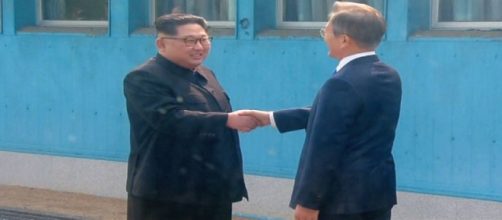Kim Jong-Un made history when he was the first North Korean leader to visit South Korea on a diplomatic mission since the 1950s. Both Kim Jong-un and his counterpart Moon Jai-in say that these talks will begin the process of bringing the 1950-53 conflict to a close and are looking to work with both the US and China, which will bring a formal end to the conflict.
Mr Moon and Mr Kim said they would hold three- or four-way discussions with the US and possibly China, with a view to signing the treaty later this year.
The Summit
This is a huge diplomatic move by the secretive state, who have been in the US crosshairs for some time now.
This visit is just the beginning of talks between the two states, where they are looking to formally bring to close the Korean War, 65 years after hostilities ended. Both leaders have stayed that they wish to hold discussions with the US and possibly China, with the view to signing a treaty at the end of the year. Russia have welcomed the talks to help deescalate the tensions within the region.
The Two Korean leaders also signed a joint declaration to agree to stop all hostile acts over “land, sea and air” that can cause military tensions and clashes. Significantly, both leaders have expressed their commitment to complete denuclearisation of the region. However, there hasn’t been a specific measure mentioned to complete this objective.
Previously, Kim Jong-un has stated that it can disarm only when the US withdraws its 28,500 troops in South Korea.
Why did North Korea want Nuclear weapons?
From beyond the Korean War, when UN led troops laid waste to villages, crops and communications, to the use of napalm that turned white snow black. The constant rhetoric from Western media to portray the leader of North Korea (NK) as ‘mad’, is simply a guise to make it easier to convince the public that war is necessary for the state to be brought into line with US and UK imperialism. When Korea was originally partitioned, it was the North that was given to Russia and South to Western nations and this geopolitical struggle still resides today.
In 2003, the US scrapped the 1994 agreement, which meant that NK would suspend its nuclear program if the US builds two light water reactors within the state, along with a step-by-step normalisation of relations. Even after the US had scrapped the agreement, NK had not reinstated its nuclear program on the reactors, which by now would be making enough plutonium to be making several nuclear weapons a year if they had done at the time. However, George Bush had decided that NK were part of the ‘axis of evil’.
This was when he withdrew from the framework and invaded Iraq on the false claims of WMDs, after which NK began enriching uranium and made subsequent progress towards developing ballistic missiles capable of delivering nuclear weapons.
But in September 2016, North Korean cyber-defence forces hacked into South Korean military computers and downloaded 235 gigabytes of documents. These documents contained evidence that the US had been planning a ‘regime change’ in NK and assassinate Kim Jong-un.
This triggered the alarm bells in Pyongyang and the awareness of the fate of Iraqi and Libyan leaders, Saddam Hussein and Muammar Gaddafi, the state quickly began a crash program to expand its nuclear weapons capabilities. Importantly, they were developing their ability to launch a retaliatory strike at the US. But the Western media have largely left out the information that shows Kim Jong-un in a different manner from the ‘mad’ leader of a secretive state who is developing nuclear weapons, as they are purely for retaliation against US escalation and their desire to forcibly remove the leader.

